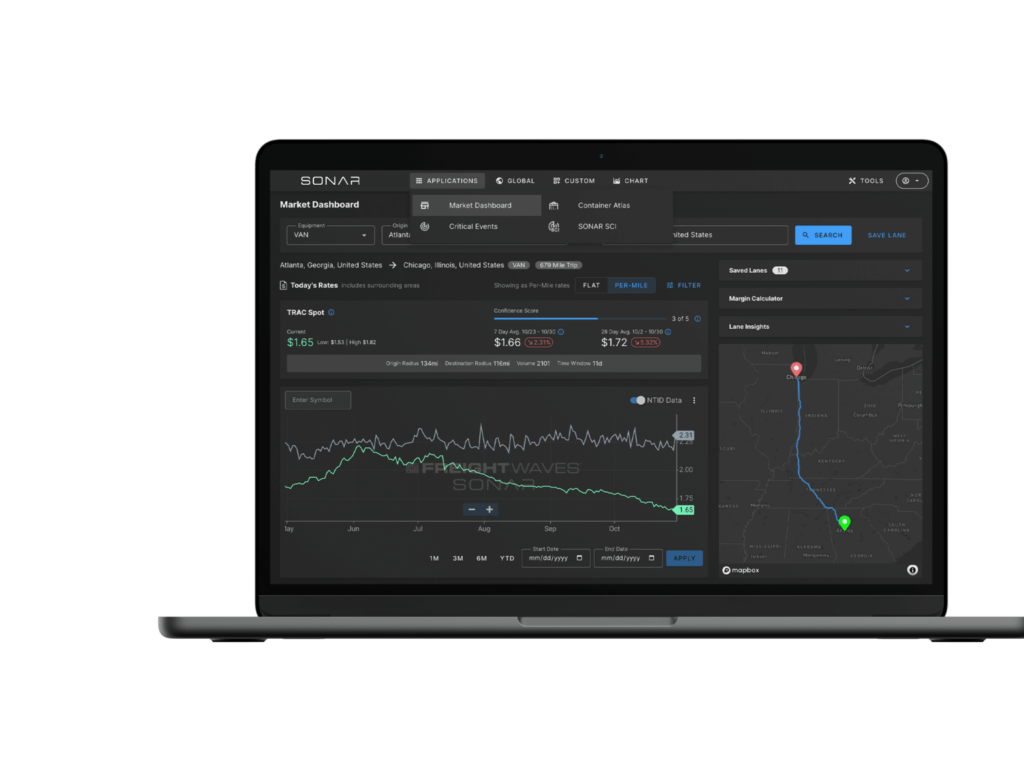It’s another Monday and the SONAR team is ready for another “SONAR Indexes & Insights”. Each Monday, you’ll learn about another index found within the freight forecasting platform from FreightWaves, SONAR. This week we’ll focus on freight volumes by defining “What is the Outbound Tender Volumen Index (OTVI)” and by concluding what these historic freight volumes mean for shippers, carriers, brokers, and other freight market participants.
The Outbound Tender Volume Index (OTVI) is an index of electronically tendered freight volumes on a given day.
A tender is a load offer from a shipper to a trucking company that is sent electronically. These are actual loads and are transmitted a few days before they are scheduled to be picked up. This is the most current and reliable indicator of market demand.
The FreightWaves SONAR outbound tender volume index (OTVI.USA) shows tender load volumes for the U.S. Users can also drill down to specific regions and market granularity. The index was created with a base of 10,000 on a national level from March 1, 2018 volumes. OTVI.USA currently is at 9,214. This means that outbound tender volumes for the entire USA are at 92.14% of their March 1, 2018 levels. The formula to calculate this is: 9,214/10,000= 92.14%.
OTVI can be broken down by five different lengths of haul, allowing SONAR users to see freight volumes, and the historical trends in freight volumes based on the distance a load travels from a market. These include city/local loads (COTVI), short-haul loads (SOTVI), mid-haul loads (MOTVI), tweener loads (TOTVI) and long-haul loads (LOTVI).

In the chart above, SONAR is comparing the main OTVI index for the Chicago market to three different OTVI length of haul indices – short-haul (SOTVI.CHI), mid-haul (MOTVI.CHI) and long-haul (LOTVI.CHI).
Carriers: If a carrier prefers regional loads, its staff can view the MOTVI map above to see which markets have the highest volumes for loads that deliver 251 to 450 miles from a market. Markets with darker shades of blue will provide the most freight by length of haul to keep a carrier’s trucks rolling. The markets with lighter shades have lower freight volumes, signaling an area where there is less demand for capacity.
Brokers: Carrier rates can vary based on the destination of your load. Loads that deliver into a low volume market might cost you a higher rate per mile than loads that deliver into high volume markets. SONAR’s length of haul indices allow brokers to break down the destination markets by lanes to see if the volumes that are shipping from that market are local, short-haul, mid-haul, tweener or long-haul loads, enabling brokers to optimize their rates.
Shippers: OTVI allows shippers to monitor the outbound volumes by length of haul in the markets you operate in. Shifts in freight volumes could lead to changes in capacity, applying upward or downward pressure to carrier rates. If you see a market’s outbound volume suddenly increase, you will be able to see which types of loads based on length of haul will be affected. If the increase is all local loads, and a shippers loads are primarily long-haul loads, capacity for long-haul shipments will not fluctuate.
The OTVI length of haul indices were built to help users identify freight volumes based on how far the load delivers from a market, and can be viewed at a national, regional or market granularity. Users can view this data on a U.S. Map, Tree Map or Chart to help them understand which lanes are shipping the most freight, or in which lanes freight volumes are declining. Shifts in freight volumes can affect freight capacity. An increase in freight volumes on a particular length of haul could tighten capacity for that lane, increasing carrier rates, while a decline in freight volumes could loosen capacity, causing carrier rates to fall.

This week, the Outbound Tender Volume Index (OTVI) climbed another 3.5% to a new all-time high of 14,276. OTVI has posted a string of consecutive new all-time highs for many weeks now. On a year-over-year basis, outbound tender volumes are up 39% and 42% above 2018 levels.
Please note that when we refer to volumes within the context of this weekly article, we mean “outbound tender volumes” which includes both accepted loads and rejected loads.
This freight level is remarkable for a few reasons. First, there are no signs of any sort of typical seasonality this year; secondly, other parts of the economy have stalled and unemployment remains extremely high; lastly, OTVI has crossed into uncharted territory by climbing higher than the March panic-buying spree.

The OTVI increased another 3.45% last week. The elevated volumes will continue to keep the pressure on trucking capacity for the near future. Rejection rates fell for the first time since the week following July 4th, however, as OTRI appears to have hit an upper resistance level. Freight volumes are increasing but not at an unmanageable pace like the one seen in mid-July when the OTVI was growing 10%-15% per week. Even though rejection rates slipped, capacity is still historically tight as spot market rates are still growing in many areas. Pockets of tightness have shifted from some of the larger markets to smaller markets across the country as carriers recognize they can get both consistent volume and rates from some of the nation’s largest outbound centers, leaving the smaller areas exposed.
